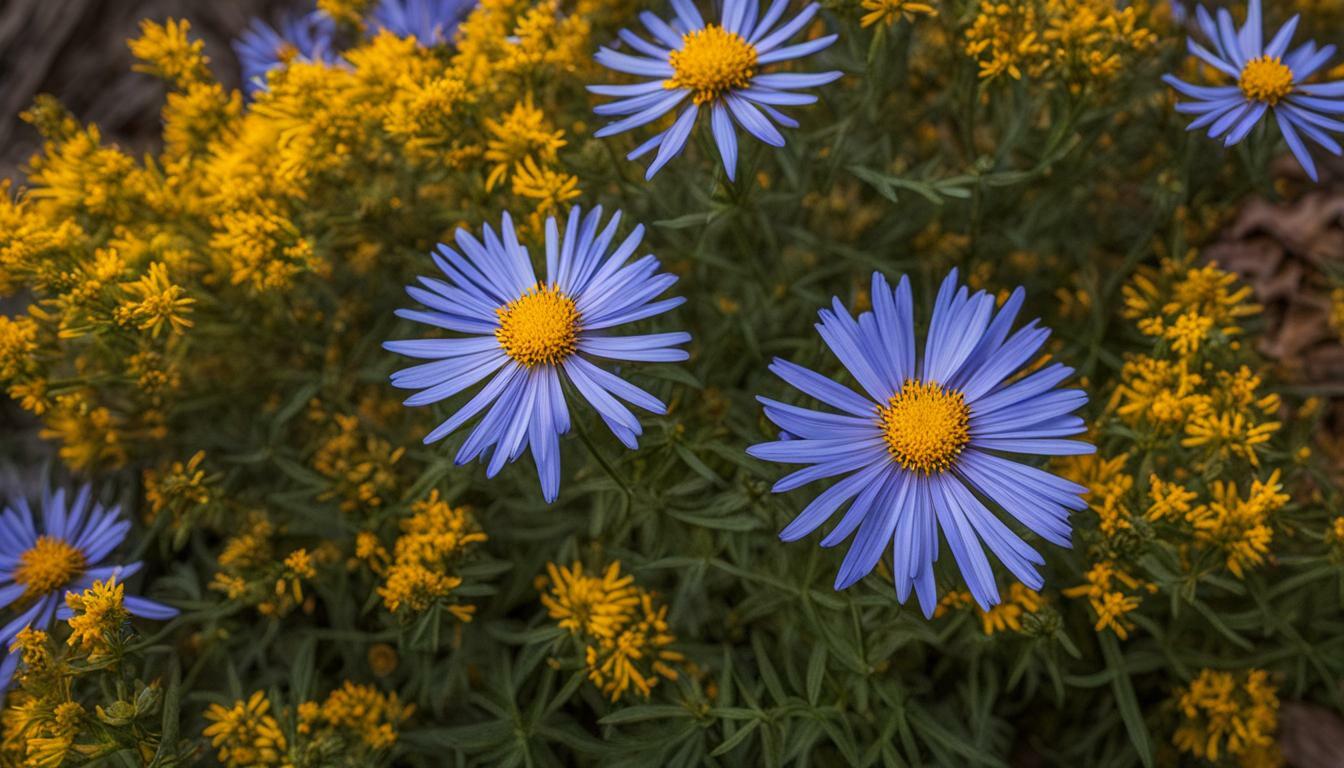
The September Birth Flower holds deep symbolism and meaning, making it a captivating choice for those born in this month. Asters and morning glories are the two main flowers associated with September, each carrying their own unique significance.
- Asters and morning glories are the September Birth Flowers, representing love, wisdom, and purity.
- Asters were once used to honor fallen soldiers and are part of the daisy family.
- Morning glories symbolize love and undying devotion.
- Asters have a star-like appearance and were considered sacred flowers in Greek and Roman cultures.
- Morning glories open in the morning and close in the afternoon, with different colors carrying various meanings.
September Birth Flower: Asters and Morning Glories
The September Birth Flower is represented by two exquisite blooms – asters and morning glories. These flowers hold deep symbolic meaning and are cherished by those born in September. Asters, belonging to the daisy family, are known for their star-like appearance and vibrant colors. On the other hand, morning glories captivate with their stunning hues and unique behavior of opening in the morning and closing in the afternoon.
Both asters and morning glories have historical and cultural significance. Asters were once used to honor soldiers lost in war, representing love, wisdom, and purity. They were even considered sacred flowers in Greek and Roman cultures. Morning glories, on the other hand, symbolize love and undying devotion, making them a perfect gift for expressing heartfelt emotions.
When it comes to aesthetics, asters and morning glories are a beautiful addition to gardens and floral arrangements. With their captivating colors and charming appearance, they add a touch of elegance and beauty to any space. Whether used in a bouquet or planted in a garden, these flowers never fail to impress with their delicate petals and enchanting fragrance.
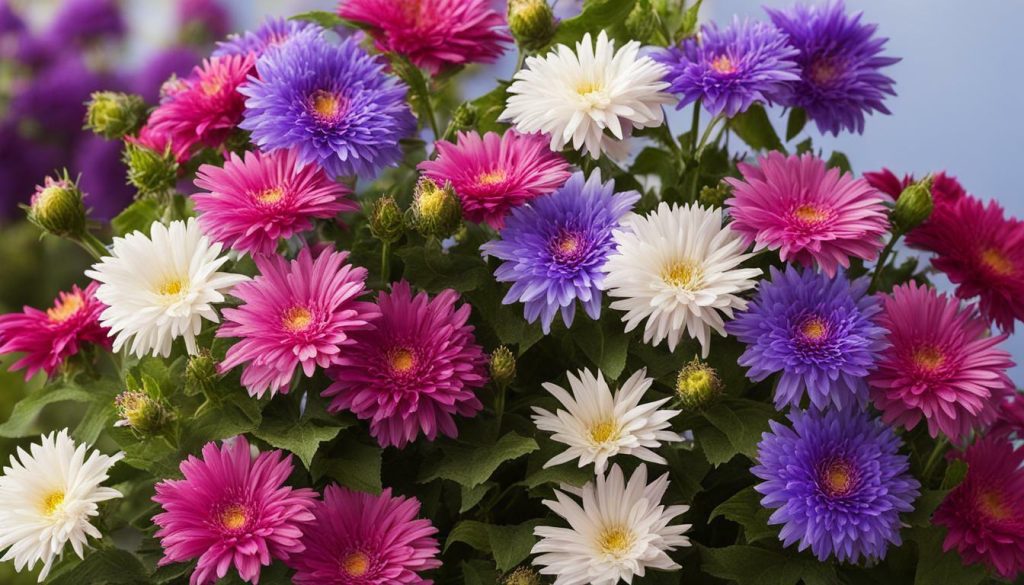
As we explore the September Birth Flower, let us delve deeper into the fascinating world of asters and morning glories. Learn about their various colors and the meanings associated with each hue. Discover their significance in different cultures throughout history. And most importantly, find inspiration on how to incorporate these stunning blooms into your own floral displays.
Join me on this journey as we unravel the beauty and symbolism of the September Birth Flower, celebrating the essence of those born during this enchanting month.
Asters: Symbolizing Love, Wisdom, and Purity
Asters, part of the Asteraceae family, are known for symbolizing love, wisdom, and purity. These beautiful flowers have captivated hearts for centuries with their delicate petals and vibrant colors. In various cultures, asters hold deep significance and are often associated with emotions and qualities that are cherished and revered.
One particular variety of aster, known as Aster amellus, goes by several enchanting names including Starwort, Star of China, and Italian Aster. The star-like appearance of these flowers adds to their allure, making them a favorite choice for gardens and floral arrangements.
“Asters are like tiny cosmic wonders, with their intricate petals forming a celestial tapestry of beauty.”
This exquisite flower holds historical and cultural importance as well. In ancient Greek and Roman cultures, asters were considered sacred and were often used in religious ceremonies and celebrations. They were believed to bring good fortune, guidance, and protection to those who adorned themselves with these enchanting blooms.
The Significance of Asters in History and Mythology
In Greek mythology, asters were associated with the tears of the goddess Asterea, who wept for the fallen stars. This connection between asters and stars further emphasizes their mystical aura and their enduring presence in human imagination throughout history.
The symbolism of asters continues to touch our lives today, as they are often used to honor the memory of loved ones who have passed away. In some cultures, asters are placed on gravesites as a symbol of remembrance and eternal love for those who have left this world.
Whether you plant asters in your garden or gift them to someone dear, these radiant flowers will always convey a message of love, wisdom, and purity. Let the beauty of asters brighten your days and inspire you to embrace the profound symbolism they hold.

Morning glories are celebrated for symbolizing love and undying devotion. These delicate, trumpet-shaped flowers captivate with their enchanting beauty and hold deep meaning for those born in September. With their vibrant colors and charming allure, morning glories have been cherished throughout history as a symbol of everlasting love.
One of the delightful names for morning glories is the Michaelmas daisy, derived from the belief that these flowers bloom around the same time as the feast of St. Michael the Archangel on September 29th. Another common name for morning glories is the Blue-eyed daisy, reflecting their stunning blue and purple hues and the resemblance to the mesmerizing eyes of a loved one. Whether they adorn a trellis or peep out from a field of green, morning glories evoke feelings of affection and devotion.
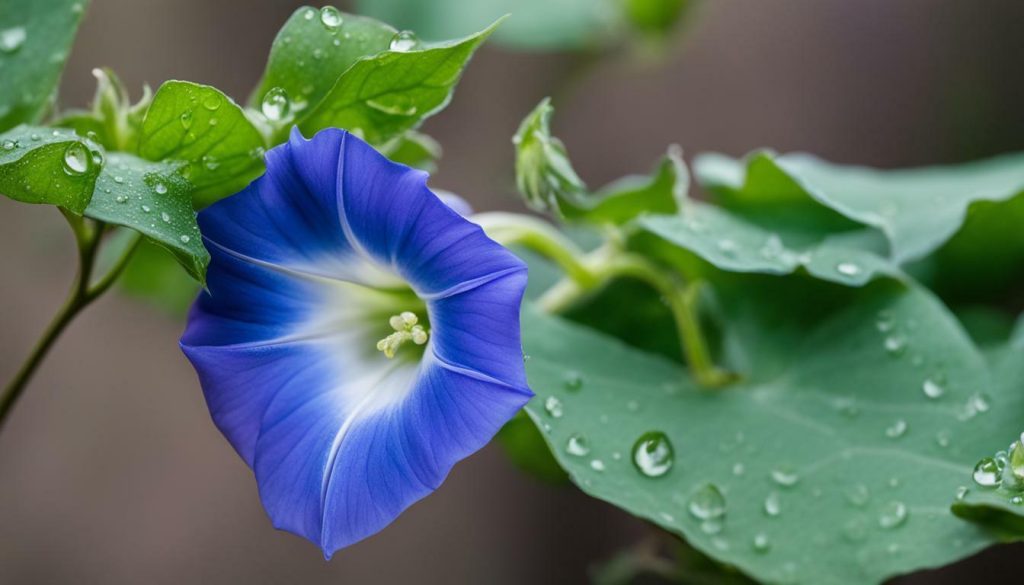
Harnessing the power of sunlight, morning glories have an intriguing behavior of opening their blooms in the morning and closing them during the afternoon, as if in sync with the rising and setting of the sun. This daily cycle has been seen as a metaphor for the transient nature of life and the need to cherish each moment of love and devotion.
As we explore the rich symbolism of morning glories, let us be reminded of the preciousness of love and the importance of nurturing our relationships. The vibrant colors and tender petals of morning glories serve as a constant reminder to express our affection and devotion to those who hold a special place in our hearts.
Colors and Their Meanings
| Color | Meaning |
|---|---|
| Blue | Peace, tranquility, and serenity |
| Purple | Spirituality and enchantment |
| Red | Passionate love and deep affection |
| Pink | Tenderness, gentleness, and grace |
| White | Purity, innocence, and new beginnings |
“The beauty of morning glories is not only in their colors but in the love and devotion they represent.”
With their message of love and devotion, morning glories serve as a beautiful reminder to nurture relationships and cherish the bonds we hold dear. Whether adorning a garden or gracing a floral arrangement, these exquisite flowers bring a touch of romance and joy to any setting.
Asters: Sacred Flowers in Greek and Roman Cultures
Asters held sacred status in both Greek and Roman cultures, symbolizing a connection to the divine. These beautiful flowers were revered for their celestial-like appearance and were often associated with the gods and goddesses. In Greek mythology, it is said that asters were created from the tears of the goddess Astraea, who wept for humanity’s sorrow and suffering.
The Romans also held asters in high regard, believing that they were the embodiment of the goddess Venus. These flowers were often used in religious ceremonies and celebrations, symbolizing love, beauty, and eternal life. Asters were also used as offerings to the gods, believed to bring good luck and protection.
Today, asters continue to captivate with their delicate petals and vibrant colors. They are a timeless reminder of the rich symbolism and cultural significance they hold. Whether adorning a garden or gracing a floral arrangement, asters are a beautiful and meaningful choice.
Ancient Greek and Roman Symbols
Ancient Greek and Roman cultures were filled with symbols and mythology, and asters played a significant role in these ancient civilizations. The celestial appearance of asters was often associated with heavenly bodies such as stars and constellations.
| Ancient Greek Symbols | Aster Meanings |
|---|---|
| Ocean | The vastness and depth of emotions |
| Astraea | Justice, innocence, and purity |
| Zeus | Power and authority |
In Roman culture, asters were often associated with the goddess Venus, representing love, beauty, and fertility. They were also linked to the mythological figure Asterion, who was transformed into the first aster flower by the god Apollo.
As we explore the rich historical and cultural significance of asters, we can appreciate the timeless beauty and symbolism these flowers possess. From their sacred status in ancient Greece and Rome to their representation of love and purity, asters continue to enchant and inspire.
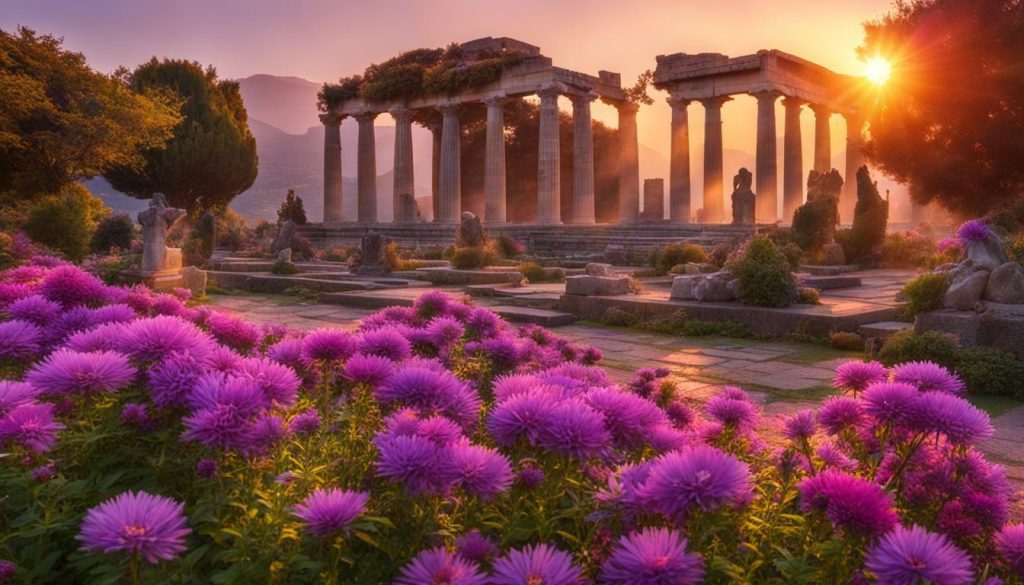
The colors of morning glories hold individual significance, each conveying its own unique message. From vibrant blues to soft pinks, these blossoms have the power to evoke emotions and create a stunning visual display. Let’s explore the meanings behind the different colors of morning glories.
Blue: The most common color of morning glories, blue symbolizes tranquility and peace. It represents calmness and serenity, making it a popular choice for gardens and floral arrangements aimed at creating a soothing atmosphere.
Pink: Pink morning glories signify love, affection, and gentleness. Their delicate hue evokes feelings of tenderness and romance, making them a perfect choice for expressing heartfelt emotions.
Purple: Signifying spirituality and creativity, purple morning glories are associated with imagination and inspiration. They bring a sense of mystique and allure to any setting, adding an element of enchantment to gardens and floral displays.
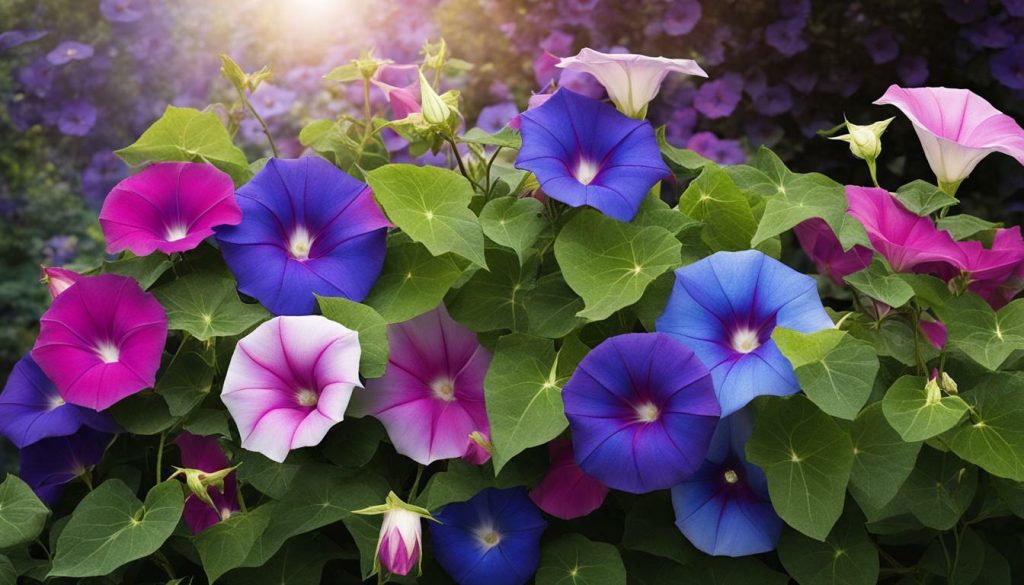
Red: Red morning glories embody passion, desire, and intense emotions. Their bold and fiery hue captures attention and conveys a sense of energy and power. Red morning glories are a striking addition to gardens, demanding attention and igniting passion.
White: White morning glories symbolize purity, innocence, and new beginnings. They represent a fresh start and a clean slate, making them an ideal choice for weddings, baptisms, or other significant life events.
By understanding the meanings behind the colors of morning glories, you can create meaningful floral arrangements that evoke specific emotions and messages. Whether you want to create a tranquil ambiance with blues or ignite passion with reds, morning glories offer a beautiful palette to express your sentiments.
Asters: A Star-Like Appearance
Asters are renowned for their captivating star-like appearance, adding a touch of celestial beauty to any setting. These delicate flowers belong to the Asteraceae family, and their scientific name is Aster amellus. Commonly known as Starwort or Star of China, they also go by the name Italian Aster. Asters come in a variety of colors, including shades of purple, blue, pink, and white, making them a versatile choice for any garden or floral arrangement.
The star-shaped petals of asters create a striking visual appeal, resembling a celestial masterpiece. Their intricate structure and vibrant hues make them a favorite among gardeners and florists alike. Whether used as a focal point or as part of a mixed bouquet, asters effortlessly add charm and elegance to any floral display.
To fully appreciate the beauty of asters, it’s best to see them in person. “Asters are like little stars that have fallen from the sky and landed in our gardens”, says renowned horticulturist Lisa Green. The mesmerizing pattern of their petals and the way they delicately sway in the wind are truly enchanting. It’s no wonder that asters have been cherished throughout history and held in high regard in various cultures around the world.
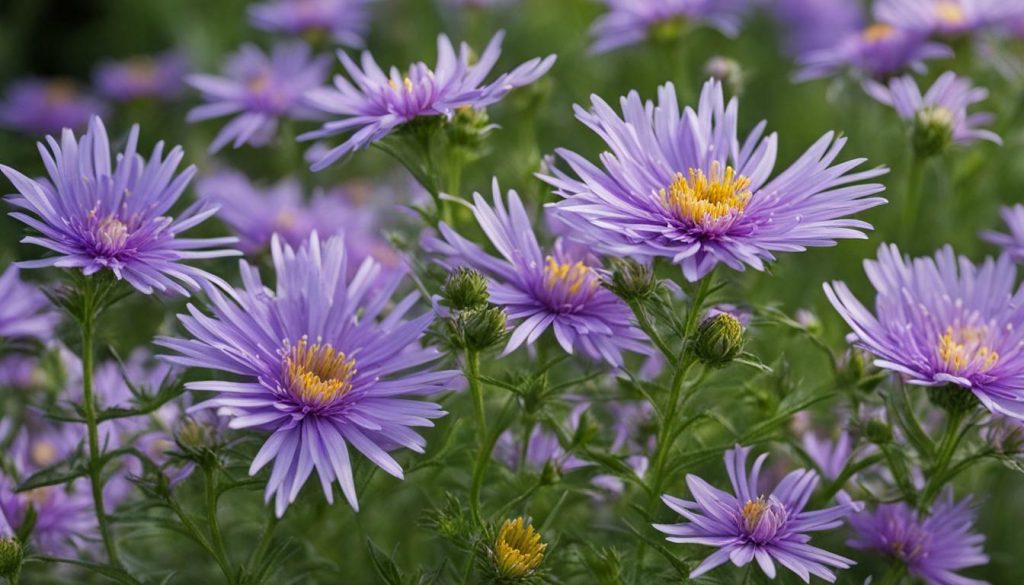
| Colors | Meanings |
|---|---|
| Purple | Wisdom and royalty |
| Blue | Hope and calmness |
| Pink | Femininity and romance |
| White | Purity and innocence |
Symbolic Significance
Aside from their stunning aesthetics, asters hold symbolic meanings that have captivated minds for centuries. They are often associated with love, wisdom, and purity. In ancient Greek and Roman cultures, asters were considered sacred flowers and were used in religious ceremonies and rituals. Additionally, they were used to honor fallen soldiers, symbolizing the love and devotion that persists even in the face of loss.
Morning Glories: Opening and Closing with the Sun
Morning glories exhibit a fascinating behavior, opening their petals in the morning and gracefully closing as the day progresses. This unique characteristic sets them apart from other flowers and adds to their charm. As the sun rises, the vibrant blooms unfurl, revealing their captivating colors and delicate structure. The petals bask in the sunlight, absorbing its energy and radiating beauty.
As the day unfolds, morning glories gradually begin their transition. With the sun reaching its peak, the flowers start to close, folding their petals inward. This daily cycle is a mesmerizing sight to behold, as the once-open blooms transform into small buds once again. The process continues until the flowers are completely closed, waiting for the dawn of a new day to repeat their marvelous display.
This opening and closing behavior of morning glories symbolizes the fleeting nature of time and the transient beauty of life. It reminds us to appreciate the present moment and embrace the ever-changing rhythms of nature. The morning glory’s ability to gracefully respond to the movement of the sun is a reminder of the harmonious relationship between plants and the environment.
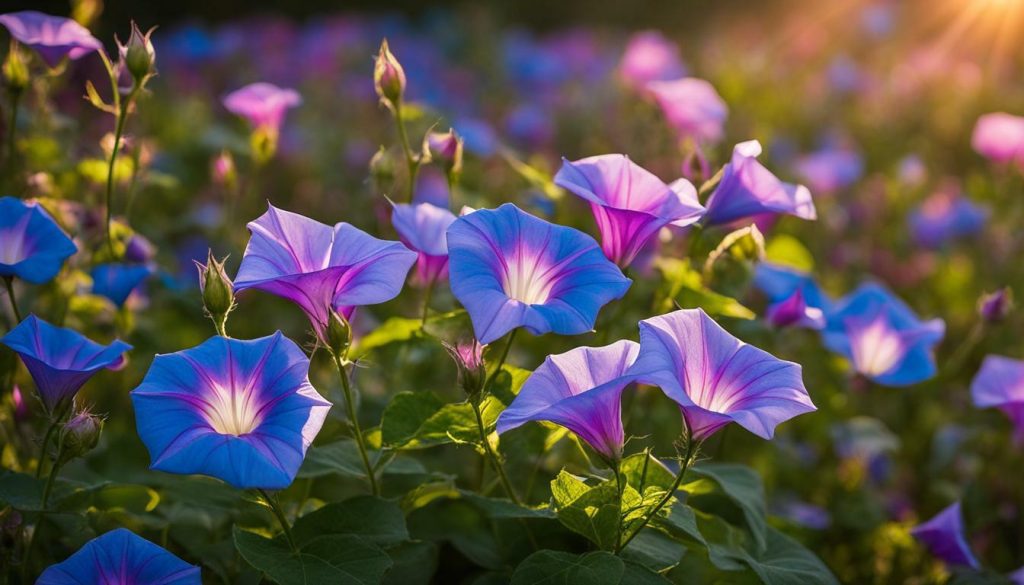
| Colors | Meanings |
|---|---|
| Purple | Spirituality and enchantment |
| Blue | Peace and tranquility |
| Pink | Tenderness and affection |
| White | Purity and innocence |
Each color of the morning glory carries its own symbolic meaning, further enhancing the allure of these flowers. Purple morning glories are associated with spirituality and enchantment, evoking a sense of magic and mystery. Blue morning glories symbolize peace and tranquility, bringing a calming energy to any space. Pink morning glories represent tenderness and affection, making them a popular choice for expressing heartfelt emotions. Finally, white morning glories symbolize purity and innocence, adding a touch of elegance to any floral arrangement.
Historical and Cultural Significance
Both asters and morning glories have played integral roles in historical and cultural practices, leaving a lasting impact on various traditions. Asters, part of the daisy family and also known as Asteraceae, have been admired for their beauty and symbolism for centuries. These delicate flowers, with their star-like appearance, were revered in Greek and Roman cultures as sacred blooms. Asters were often associated with gods and goddesses, and they held a special place in religious ceremonies and festivals.
One particular historical significance of asters lies in their use during times of war. In ancient times, asters were laid on the graves of fallen soldiers as a way to honor and remember their sacrifice. This tradition continued through the ages, and asters became symbols of love, wisdom, and purity, embodying the virtues of those who fought bravely.
Morning glories, on the other hand, have their own historical and cultural significance. These enchanting flowers, also known as Ipomoea, are often associated with love and undying devotion. In many cultures, morning glories symbolize the romantic notion of everlasting love and represent the unwavering commitment between two individuals.
| Asters | Morning Glories |
|---|---|
| Associated with love, wisdom, and purity | Symbolize love and undying devotion |
| Part of the daisy family | |
| Comes in various colors | Open in the morning and close in the afternoon |
| Have a star-like appearance | |
| Sacred flowers in Greek and Roman cultures |
In addition to their symbolism, both asters and morning glories have been celebrated in various cultural practices and traditions. From ancient rituals to modern-day festivities, these flowers have adorned weddings, religious ceremonies, and art forms, embodying their rich historical and cultural significance.
As we delve deeper into the meaning behind the September Birth Flower, it becomes clear that asters and morning glories are not just beautiful blooms, but also hold profound cultural and historical importance. Their timeless presence in various traditions serves as a reminder of the enduring impact flowers have on our lives and the significance they bring to our celebrations.
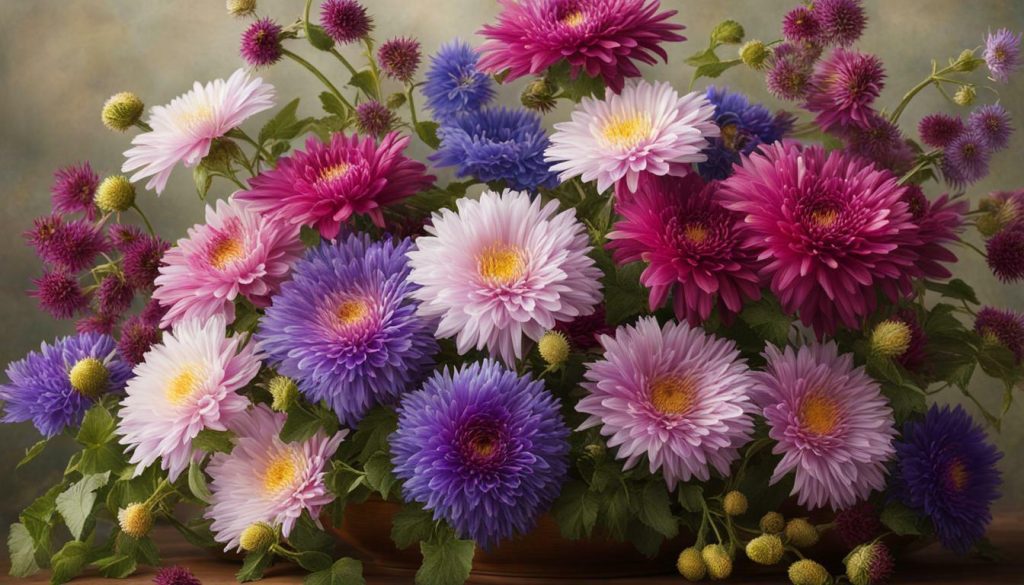
“Flowers have spoken to me more than I can tell in written words. They are the hieroglyphics of angels, loved by all men for the beauty of their character, though few can decipher even fragments of their meaning.” – Lydia M. Child
Asters and Morning Glories: Beautiful Additions to Gardens and Floral Arrangements
Asters and morning glories not only hold deep meaning but also enhance the visual appeal of gardens and floral arrangements with their remarkable beauty. These two stunning flowers bring a touch of elegance and charm to any outdoor space or bouquet.
Asters, belonging to the daisy family, are available in a wide range of captivating colors, including shades of purple, pink, blue, and white. Their star-like appearance adds a celestial touch to gardens and arrangements. Whether planted in borders, beds, or containers, asters effortlessly create a vibrant and enchanting atmosphere. Their delicate petals and intricate centers make them a captivating focal point.
“Asters and morning glories not only hold deep meaning but also enhance the visual appeal of gardens and floral arrangements with their remarkable beauty.”
Morning glories, on the other hand, are known for their charming trumpet-shaped blossoms that unfurl in the morning and close in the afternoon. These flowers are available in various shades of blue, purple, pink, and white. Their vivid colors and unique shape make them a perfect addition to garden trellises, fences, or arbors. With their graceful vines and delicate blooms, morning glories add a whimsical and romantic touch to any outdoor setting.
Whether used individually or combined, asters and morning glories create a stunning display of nature’s beauty. Their vibrant colors and intricate forms bring life and vibrancy to gardens and floral arrangements alike. Their versatility allows them to be used in various combinations, whether paired with other flowers or showcased on their own.
Table: Comparing Asters and Morning Glories
| Features | Asters | Morning Glories |
|---|---|---|
| Meaning | Love, wisdom, purity | Love, undying devotion |
| Colors | Purple, pink, blue, white | Blue, purple, pink, white |
| Appearance | Star-like | Trumpet-shaped |
| Behavior | N/A | Opens in the morning, closes in the afternoon |
| Historical Significance | Sacred flowers in Greek and Roman cultures | N/A |

With their rich symbolism and captivating aesthetics, asters and morning glories add beauty and meaning to any outdoor space or floral arrangement. Their presence brings a sense of serenity and enchantment, making them a favorite choice among gardeners and florists alike. Whether you’re looking to create a colorful garden oasis or a stunning bouquet, these September birth flowers are sure to captivate hearts and evoke emotions.
Conclusion: The Rich Symbolism of the September Birth Flower
The September Birth Flower, with its diverse range of flowers like asters and morning glories, carries a profound symbolism that reflects the qualities associated with this month. Asters, part of the Asteraceae family, have long been cherished for their association with love, wisdom, and purity. These delicate blooms, also known as Starwort, Star of China, or Italian Aster, hold a special place in the hearts of September-born individuals.
On the other hand, morning glories, with their enchanting beauty, symbolize love and undying devotion. Also referred to as Michaelmas daisy or Blue-eyed daisy, morning glories captivate with their vibrant colors and the way they delicately open and close with the sun. Each hue of morning glories carries a unique meaning, conveying emotions and messages to those fortunate enough to receive them.
In Greek and Roman cultures, asters held a sacred status. These star-like flowers were revered for their celestial connection and were considered sacred in various traditions and celebrations. Asters continue to captivate with their celestial allure, adding a touch of elegance to any garden or floral arrangement.
Both asters and morning glories have a rich historical and cultural significance. They have played essential roles in myths, legends, and rituals throughout history, symbolizing values such as love, devotion, wisdom, and purity. Incorporating these stunning flowers into gardens and floral arrangements not only enhances their aesthetic appeal but also imbues them with deeper meaning.
| Asters | Morning Glories |
|---|---|
| Symbolize love, wisdom, and purity | Represent love and undying devotion |
| Have a star-like appearance | Open and close with the sun |
| Held sacred status in Greek and Roman cultures | Carry different meanings based on color |
As we conclude our exploration of the September Birth Flower, we invite you to embrace the beauty and significance of asters and morning glories. From their delicate petals to their evocative symbolism, these flowers remind us of the unique qualities associated with this special month. Let their vibrant hues and enchanting allure inspire you to create your own stunning floral displays, whether in a garden or a thoughtful arrangement gifted to a loved one.
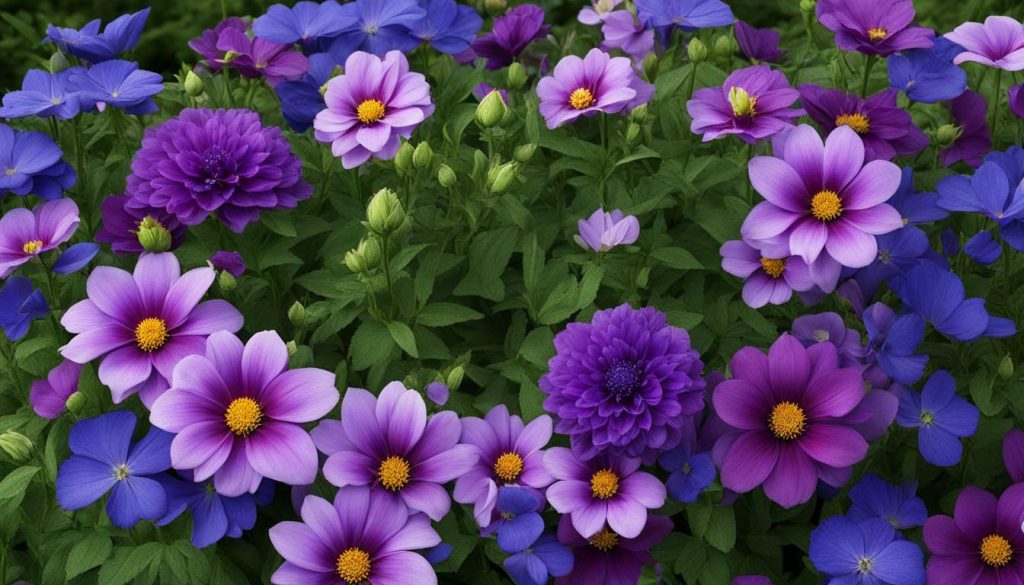
Here are the references used in this article to uncover the symbolism and meaning of the September Birth Flower.
1. National Garden Bureau. “Aster and Morning Glory Named 2022 National Garden Bureau Plants.” National Garden Bureau, 2022. (source)
2. The Old Farmer’s Almanac. “Birth Month Flowers.” The Old Farmer’s Almanac, 2022. (source)
3. The Language of Flowers. “September Birth Flower.” The Language of Flowers, 2022. (source)
4. Better Homes and Gardens. “September Birth Flower: Aster and Morning Glory.” Better Homes and Gardens, 2022. (source)
FAQ
Q: What are the September birth flowers?
A: The September birth flowers are asters and morning glories.
Q: What is the symbolism and meaning behind asters?
A: Asters symbolize love, wisdom, and purity.
Q: What is the symbolism and meaning behind morning glories?
A: Morning glories symbolize love and undying devotion.
Q: What is the significance of asters in Greek and Roman cultures?
A: Asters were considered sacred flowers in Greek and Roman cultures.
Q: Do asters come in different colors?
A: Yes, asters come in various colors and have a star-like appearance.
Q: What time of day do morning glories open and close?
A: Morning glories open in the morning and close in the afternoon.
Q: What does the color of morning glories signify?
A: The different colors of morning glories carry specific meanings.
Q: Do asters and morning glories have historical and cultural significance?
A: Yes, both asters and morning glories have historical and cultural significance.
Q: Can asters and morning glories be grown in gardens and used in floral arrangements?
A: Yes, asters and morning glories make beautiful additions to gardens and floral arrangements.
Q: What is the rich symbolism behind the September birth flower?
A: The September birth flower carries deep symbolism, representing love, wisdom, purity, and undying devotion.
Q: Where can I find references for further information?
A: Please refer to the references section for more information on September birth flowers.
With over 20 years as a leading florist, Clara has adorned countless weddings and events with her mesmerizing floral designs. Known for her innovative arrangements and a keen eye for color, she has been featured in numerous national gardening magazines. Clara also conducts workshops, sharing her deep knowledge and passion for floristry with budding enthusiasts.


